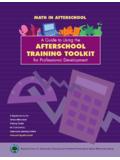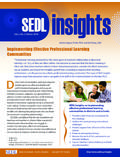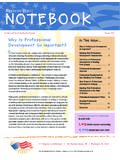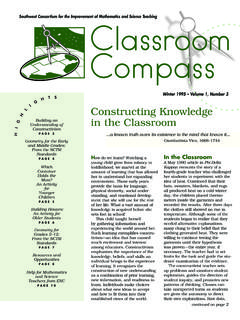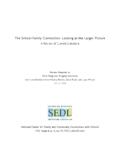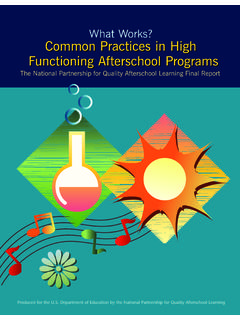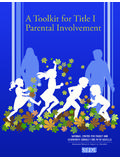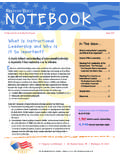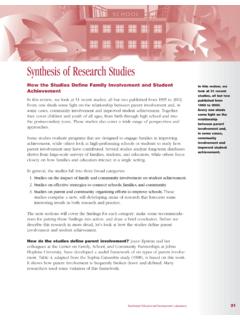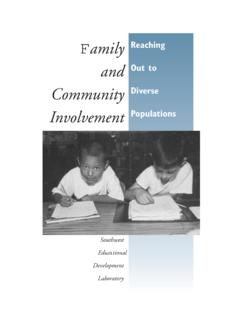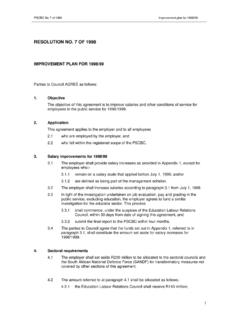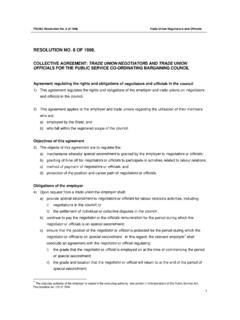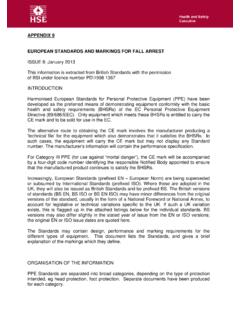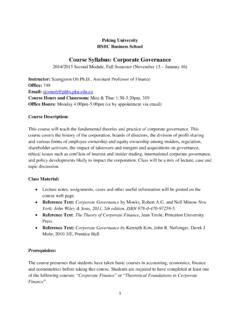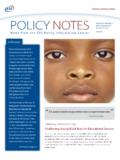Transcription of Fall 1998 Volume 4, Number 2 The Rhythm of …
1 Continued on page 2 The Rhythm ofMathematicsPAGE 1 StandardsExcerpts from the NCTMS tandardsPAGE 2 Making MathematicsMovePAGE 5 StandardsPAGE 8 Resources andOpportunitiesPAGE 10 The Rhythm ofMathematicsEisenhower Southwest Consortium for the Improvement of mathematics and Science TeachingTwo subject areas that might appear to be impervious to integration aremathematics viewed as abstract and cold by many and dance andmusic usually perceived as emotional. The work of several New Mexicoschools shows that these two areas have much to offer each and music share a concern with numbers and patterns of change. In music and dance these patterns are called 1998 Volume 4, Number 2We enter the room silently, quietly flexing our fingers readying ourselves to create rhythms with our hands uponclassroom chairs. The music created from the patterning of our hands tapping the chairs in sync takes us to a mathematic realm aswe fit our notes and time into an artistic form.
2 We are lifted to a place and time with a oneness of music and math. One-eighth time takes us to a fast movement, a flurry of fingers, a creation of a Rhythm above all we have done. We slow down to one-half time, easing ourfingers to a slower time frame, artisticallydrumming fractions. How do we attain this? Very easily and simply we kneel upon the floor in front of plastic chairs. We, ourselves, are the expensive instruments.}}Cris Marie Alton, teacher of ten, eleven, andtwelve year olds at Alvord Elementary School,a collaboration of the Santa Fe Public Schoolsand the College of Santa Fe, New Mexico understanding is valued. After thedrumming, performers and par-ents gather to talk over the stimu-lating evening. In the excitement,only a few remember how muchmore the students have learnedfrom their percussive work. The Results of the ClassAlvord and several other NewMexican schools introduce rhyth-mic, athletic, and high energymovement and music to 8 to 12year olds.
3 While the children andtheir families obviously enjoy boththe performance and the workthat goes into it, the program haseven deeper intentions. The teach-ers know that few if any of theirstudents will become professionalmusicians or dancers. They dohope that all of them will becomelife-long learners who search forexcellence in all their drumming program nourishesthoughtful habits of mind andhelps the children build contactsbetween the rhythms they pro-duce and basic knowledge andunderstanding they need in everyday life. Through the drumming pro-gram, the students realize thatperformance is a way to sharelearning. They learn to define andwork toward goals consistent withtheir individual abilities and tocooperate with others in reachingshared goals. As a result of suchshared work, they come to seehow the work of each persondepends on the work of others. Students who have beenthrough the drumming experiencehave also learned to link move-ment, music, and Rhythm to basicmathematical concepts.
4 As part ofthe drumming program, ValdezAbeyta y Valdez, a music teacherat several New Mexico schools,and faculty from Alvord worktogether to help all childrencomprehend the mathe-matics that under-lies the worldwe experienceevery day. In thisCLASSROOM COMPASSThe Rhythm of mathematics , continued from page 1 Each year the students at theAlvord Elementary School repeatthis scene. Before their familiesand friends they drum and leapand twirl. The hall is packed sincefrom year to year communitymembers look forward to receivingtheir invitations to the Alvord performance. The students havealso been looking forward to thisday with the combination ofexcitement and fear that all performers feel. They know that,however they do, their efforts willbe acknowledged, rewarded, andremembered by the community inwhich they PerformanceThe performance begins with twodrum captains beating their handson chairs. The simple Rhythm theyproduce guides the performersinto the room.
5 Each child, dressedlike his neighbors, takes his placebehind a chair. Soon all of thechildren have joined in the rhythmset by the captains as theymethodically strike the chairs infront of them. This sound does not last long; soon it moves to evermore complex rhythms. By theend of the hour, the intricate beat-ing has brought the audience toits feet as the whole room joins in stomping and clapping to the performers sounds. All semester the students haveworked toward this night. Finally,they have put themselves and theirabilities on public display and theirpeers and parents have shownthem that theirperformance andThe Standards of the NationalCouncil of Teachers ofMathematics emphasizes that patterns are of recurringimportance to mathematics . The following is excerpted fromthe NCTM s Curriculum andEvaluation Standards for SchoolMathematics. Reston, VA: K-4: Standard 13:Patterns and Relationsp. 60 Patterns are who are encouraged tolook for patterns and to expressthem mathematically begin tounderstand how mathematicsapplies to the world in which theylive.
6 Identifying and working with a wide variety of patterns helpschildren to develop the ability toclassify and organize patterns in numbers,geometry, and measurement helpsthem understand connectionsamong mathematical topics. Such connections foster the kind of mathematical thinking that serves as a foundation for the more abstract ideas studied in later grades. From the earliest grades, thecurriculum should give studentsopportunities to focus on regulari-ties in events, shapes, designs,and sets of numbers. Childrenshould begin to see that regularityis the essence of idea of a functional relation-ship can be intuitively developedthrough observations of regularityand work with generalizable patterns. Physical materials and pictorialdisplays should be used to helpchildren recognize and create patterns and varied representationsof the same pattern helps childrenidentify its properties. The use of letters and other symbols in generalizing descriptions of theseproperties prepares children touse variables in the future.
7 Thisexperience builds readiness for ageneralized view of mathematicsand a later study of on page 82 CLASSROOM COMPASS program teachers are often asmuch learners as students. Eventhose teachers who have beenthrough a drumming exercisemany times learn new things each year. While dance and music moti-vate most students through excit-ing action, the excitement thesedisciplines generate can also helpthem understand more abstractconcepts. They learn to work outmathematical meaning in new andconcrete ways. From a naturaland intuitive understanding ofhow his or her own body works, astudent can develop an awarenessof the working of mathematics inthe physical world. (See art stan-dard on page 8.)For example, clapping two halfbeats in the place of one wholebeat can help children begin tounderstand the meaning of frac-tions. Learning to beat half time,quarter time, and eighth time,children can feel fractions in theirown bones as they also begin towork with the larger mathematicaltheme of patterns and theirchanges.
8 (See standards beginningon page 2.)The idea of patterns will surfaceagain as the students put togethersteps, sounds, and movements tocreate their performance. Thisearly attempt at choreography can also move them into moremathematics, since an interestedteachercan help students com-pare the shapes they make withtheir bodies and space duringdance to similar geometric shapes. In using Rhythm to teach mathe-matics Alvord is part of a long tradition. Western culture has recognized the connection betweenmusic and mathematics since thetime of the ancient Greeks. ThePythagoreans (of the famous theo-rem regarding the square of thehypotenuse of a right triangle) usedharmony and Rhythm as a basis fortheir mathematical ideas. Musicteachers have long expressed thenotion that learning musicimproves mathematical abilitiesand scientists recently establishedexperimentally that the link exists. The Mozart EffectDuring the 1990s researchers atUniversity of California at Irvineled by Gordon Shaw, a physicist,and Frances Rauscher, a cellistand a psychologist, studied therelation between music and intelli-gence.
9 In one study they dividedthree and four year olds into threegroups. One group received pianolessons, another private computerlessons, and a third either studiedsinging or had no special lessonsat all. After six months, the groupstudying piano was the only one to show a significant increase inspatial-temporal reasoning; in fact,these children scored 34 percenthigher than did the next group.(Spatial-temporal reasoning isrequired for certain higher brainfunctions and is employed inchess, mathematics , engineering,and composing music. It enablesthe thinker to put mental imagesinto many different forms withouthaving to use a concrete model ofany of the forms.) This increase inspatial-temporal reasoning hasbeen dubbed the Mozart Effect. Musical intelligence follows the same sequences as spatial-temporal reasoning, so learningmusic is like a warm-up exercisefor these other reasoning believe that musiccalls on abilities that increase student capacity to learn in otherareas.
10 Musical learning, for exam-ple, helps students develop suchmental skills as concentration,symbol recognition, and researchers go so far as tosay that musical activity repat-terns neurons to improve corticalfunctioning. Staging an actualperformance also teachesstudents the value of cooperation and training appears tofunction on several levels. First,musical activities call on the entirebody: the muscles of the arms andhands, those that control breath-ing and the voice, the coordinationof movements. At the same time,music can lead students througha series of victories that give thema sense of the necessary sequencesof learning and pacing. They findout how it feels to accomplish theirown learning goals anddevelopsought-after self-esteem throughactually learning difficult pictures of themselves aslearners become more realisticand each student develops a bet-ter idea of how she or he learns. Multiple IntelligencesThe work of Howard Gardner, ofProject Zero at Harvard University,has shown that each of us has amixture of different ways of learn-ing.
